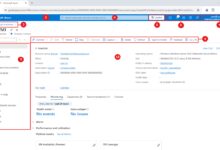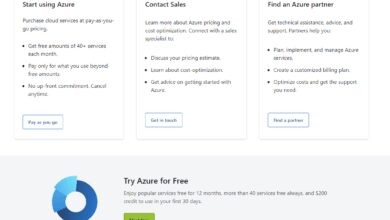Azure for Active Directory: 7 Powerful Benefits You Can’t Ignore
Looking to modernize your identity management? Azure for Active Directory isn’t just a cloud upgrade—it’s a strategic revolution. Discover how Microsoft’s hybrid identity solution transforms security, scalability, and user experience across your enterprise.
Understanding Azure for Active Directory: The Modern Identity Backbone

Azure for Active Directory, often referred to as Azure AD, is Microsoft’s cloud-based identity and access management service. It’s not just a replacement for on-premises Active Directory (AD); it’s an evolution. Designed to support modern workforces, Azure AD enables secure authentication and authorization across cloud and hybrid environments. With over 1.4 billion monthly active users, it powers identity for Microsoft 365, Azure, and thousands of third-party SaaS applications.
What Is Azure Active Directory?
Azure Active Directory (Azure AD) is a comprehensive identity and access management (IAM) platform that provides single sign-on (SSO), multi-factor authentication (MFA), conditional access, and identity protection. Unlike traditional on-premises Active Directory, which is directory services based on LDAP and Kerberos, Azure AD is built for the cloud, using REST APIs, OAuth 2.0, OpenID Connect, and SAML protocols.
- Cloud-native identity platform
- Supports web, mobile, and desktop applications
- Integrates with on-premises AD via Azure AD Connect
“Azure AD is the identity backbone for the modern enterprise.” — Microsoft Azure Documentation
How Azure for Active Directory Differs from On-Premises AD
While both systems manage user identities, their architectures and use cases differ significantly. On-premises AD is optimized for Windows domain networks, managing users, computers, and group policies within a local network. Azure AD, on the other hand, is designed for cloud-first environments, focusing on application access, user authentication, and identity governance.
- On-premises AD uses NTLM/Kerberos; Azure AD uses token-based authentication
- Azure AD supports external identities (B2B, B2C), while traditional AD does not
- Group Policy in on-prem AD vs. Conditional Access and Intune policies in Azure AD
The Role of Azure AD in Hybrid Environments
Many organizations operate in hybrid environments—part cloud, part on-premises. Azure for Active Directory bridges this gap through tools like Azure AD Connect, which synchronizes user identities from on-premises AD to the cloud. This allows seamless authentication for cloud apps while maintaining legacy systems.
- Synchronization of users, groups, and passwords
- Password hash sync or pass-through authentication
- Seamless single sign-on (SSO) for hybrid users
For more details, visit the official Microsoft hybrid identity documentation.
7 Key Benefits of Using Azure for Active Directory
Adopting Azure for Active Directory brings transformative advantages. From enhanced security to improved user productivity, here are seven powerful reasons why enterprises are making the shift.
1. Enhanced Security and Identity Protection
Security is the cornerstone of Azure AD. With built-in features like Identity Protection, Conditional Access, and Multi-Factor Authentication (MFA), Azure for Active Directory helps prevent unauthorized access and detect suspicious activities in real time.
- Risk-based conditional access policies
- Real-time threat detection using AI
- Automated remediation of risky sign-ins
“Azure AD Identity Protection reduces breach risk by up to 99.9% when MFA is enforced.” — Microsoft Security Report
2. Seamless Single Sign-On (SSO) Experience
Users today access dozens of applications daily. Azure for Active Directory provides a unified login experience across Microsoft and third-party apps. With SSO, users log in once and gain access to all authorized resources without re-entering credentials.
- Supports over 2,600 pre-integrated SaaS apps
- Custom app integration via SAML, OAuth, or password-based SSO
- Reduced password fatigue and helpdesk calls
3. Scalability and Global Reach
Unlike on-premises AD, which requires hardware scaling and domain controller management, Azure for Active Directory is inherently scalable. Whether you have 100 or 100,000 users, Azure AD automatically handles the load with high availability across global data centers.
- No infrastructure to manage
- Automatic failover and redundancy
- Supports global organizations with low-latency authentication
4. Advanced Identity Governance and Compliance
Regulatory compliance is a major challenge for enterprises. Azure for Active Directory offers robust identity governance tools, including access reviews, entitlement management, and privileged identity management (PIM).
- Just-in-time (JIT) access for administrators
- Automated access certification campaigns
- Audit trails and compliance reporting for GDPR, HIPAA, ISO 27001
5. Support for External Identities (B2B and B2C)
Modern businesses collaborate with partners, vendors, and customers. Azure for Active Directory enables secure collaboration through Azure AD B2B (Business-to-Business) and customer identity management via Azure AD B2C (Business-to-Customer).
- Invite external users with guest accounts
- Self-service sign-up and profile management in B2C
- Custom branding and user journeys
Learn more about Azure AD external identities.
6. Integration with Microsoft 365 and Azure Services
If your organization uses Microsoft 365 or Azure, Azure for Active Directory is the default identity provider. It integrates natively with services like Exchange Online, SharePoint, Teams, and Azure Virtual Machines, ensuring consistent access control.
- Centralized user provisioning and deprovisioning
- Conditional Access policies for M365 apps
- Role-based access control (RBAC) in Azure
7. Reduced IT Overhead and Operational Costs
Maintaining on-premises domain controllers, backup servers, and replication topology requires significant IT effort. Azure for Active Directory eliminates much of this burden by offloading identity management to the cloud.
- No need for physical domain controllers
- Automated updates and patching
- Lower TCO (Total Cost of Ownership) over time
How to Migrate to Azure for Active Directory: A Step-by-Step Guide
Migrating from on-premises AD to Azure for Active Directory requires careful planning. Here’s a structured approach to ensure a smooth transition.
Step 1: Assess Your Current Environment
Before migration, evaluate your existing AD infrastructure. Identify user count, group policies, applications relying on AD, and any custom integrations.
- Use Microsoft’s Azure Migrate tool for assessment
- Document dependencies and authentication methods
- Identify legacy apps that may need refactoring
Step 2: Choose the Right Deployment Model
Azure for Active Directory supports multiple deployment models: cloud-only, hybrid identity, and password hash synchronization. The choice depends on your business needs.
- Cloud-only: For organizations fully in the cloud
- Hybrid with sync: Best for gradual migration using Azure AD Connect
- Federation (AD FS): For advanced SSO scenarios (less common now)
Step 3: Implement Azure AD Connect
Azure AD Connect is the bridge between on-premises AD and Azure AD. It synchronizes user identities, passwords, and group memberships.
- Install and configure Azure AD Connect on a domain-joined server
- Select synchronization options (password hash sync or pass-through authentication)
- Enable seamless SSO for better user experience
Refer to the Azure AD Connect installation guide for detailed steps.
Step 4: Configure Security and Access Policies
Once users are synced, enforce security policies. Enable MFA, set up Conditional Access, and define role-based access.
- Require MFA for admin accounts and remote access
- Create Conditional Access policies based on user, device, location, and risk
- Use Identity Protection to monitor sign-in risks
Step 5: Test and Roll Out Gradually
Start with a pilot group—IT staff or a department—to validate the setup. Monitor logs, fix issues, and then expand to the entire organization.
- Use Azure AD sign-in logs for troubleshooting
- Train users on new login procedures
- Communicate changes to reduce confusion
Common Challenges and How to Overcome Them
While Azure for Active Directory offers many benefits, organizations often face challenges during adoption. Here’s how to address them.
Challenge 1: Legacy Application Compatibility
Some older applications rely on LDAP or NTLM authentication, which Azure AD doesn’t support natively. This can break functionality during migration.
- Solution: Use Azure AD Application Proxy to publish on-prem apps securely
- Modernize apps to use OAuth or SAML
- Keep on-prem AD running temporarily for legacy systems
Challenge 2: Password Synchronization Issues
When using Azure AD Connect, password sync failures can occur due to network issues, filtering, or encryption settings.
- Solution: Monitor sync health in the Azure portal
- Use Pass-through Authentication for real-time validation
- Ensure service accounts have proper permissions
Challenge 3: User Resistance to Change
Users accustomed to traditional login methods may resist new MFA prompts or SSO workflows.
- Solution: Provide clear training and communication
- Use adaptive authentication to reduce friction for low-risk users
- Implement a phased rollout to ease transition
Best Practices for Managing Azure for Active Directory
To get the most out of Azure for Active Directory, follow these proven best practices.
1. Implement Role-Based Access Control (RBAC)
Assign permissions based on job roles rather than giving broad admin rights. Use built-in roles like Global Reader, Helpdesk Admin, or custom roles for fine-grained control.
- Avoid assigning Global Administrator unless absolutely necessary
- Use Privileged Identity Management (PIM) for just-in-time access
- Regularly review role assignments
2. Enable Multi-Factor Authentication (MFA) for All Users
MFA is one of the most effective ways to prevent account compromise. Make it mandatory for all users, especially admins.
- Use the Microsoft Authenticator app for push notifications
- Allow backup methods like SMS or phone calls
- Consider passwordless authentication (FIDO2 keys, Windows Hello)
3. Use Conditional Access Policies Wisely
Conditional Access allows you to enforce access controls based on context. However, overly restrictive policies can block legitimate access.
- Start with monitoring mode before enforcing
- Exclude break-glass accounts from strict policies
- Combine with device compliance (Intune) for zero trust
4. Monitor and Audit Regularly
Regular monitoring helps detect anomalies and ensure compliance.
- Review sign-in logs and audit logs weekly
- Set up alerts for suspicious activities
- Use Azure Monitor and Log Analytics for deeper insights
Integrating Azure for Active Directory with Third-Party Applications
One of the biggest strengths of Azure for Active Directory is its vast ecosystem of integrations. Whether you use Salesforce, Dropbox, or Workday, Azure AD can serve as the central identity provider.
How to Add SaaS Applications to Azure AD
Azure AD offers a gallery of over 2,600 pre-integrated applications. Adding them takes minutes.
- Navigate to Azure portal > Azure AD > Enterprise Applications
- Search for the app and click “Add”
- Configure SSO (SAML, OAuth, or password-based)
- Assign users or groups
Custom Application Integration
For apps not in the gallery, you can add them as custom enterprise applications.
- Provide metadata URL or upload SAML certificate
- Map attributes like email, name, and role
- Test SSO using the built-in test tool
Using Azure AD as a SAML Identity Provider
You can configure Azure for Active Directory to act as a SAML IdP for any service that supports SAML 2.0.
- Download federation metadata XML
- Provide it to the service provider (e.g., AWS, Okta, Zoom)
- Map claims to user attributes
See Microsoft’s guide on non-gallery app integration.
Future Trends: The Evolution of Azure for Active Directory
Azure for Active Directory is not static—it’s evolving to meet future security and identity challenges. Here are key trends shaping its roadmap.
1. Passwordless Authentication Becomes Standard
Microsoft is pushing toward a passwordless future. Features like FIDO2 security keys, Windows Hello, and the Microsoft Authenticator app allow users to log in without passwords.
- Reduces phishing and credential theft
- Improves user experience
- Supported across Windows, iOS, and Android
2. Zero Trust Architecture Integration
Azure AD is a cornerstone of Microsoft’s Zero Trust model: “Never trust, always verify.” Conditional Access, device compliance, and identity verification are central to this approach.
- Requires continuous validation of user and device trust
- Integrates with Microsoft Defender for Identity
- Enables secure access from any location
3. AI-Powered Identity Protection
Microsoft is enhancing Azure AD Identity Protection with AI and machine learning to detect anomalies and automate responses.
- Real-time risk detection (impossible travel, anonymous IP)
- Automated user risk remediation
- Integration with Microsoft Sentinel for SIEM
4. Expansion of B2B and B2C Capabilities
As digital ecosystems grow, Azure AD B2B and B2C are becoming more powerful, supporting customer portals, partner collaboration, and citizen services.
- Custom user flows and journeys
- Integration with social identity providers (Google, Facebook)
- Support for large-scale customer identity management
What is Azure for Active Directory?
Azure for Active Directory (Azure AD) is Microsoft’s cloud-based identity and access management service. It enables secure user authentication and authorization for cloud and on-premises applications, serving as the foundation for Microsoft 365, Azure, and thousands of SaaS apps.
How does Azure AD integrate with on-premises Active Directory?
Azure AD integrates with on-premises AD through Azure AD Connect, which synchronizes user identities, passwords, and groups. It supports password hash synchronization, pass-through authentication, and seamless SSO for hybrid environments.
Is Azure AD the same as Windows Server Active Directory?
No. While both manage identities, Azure AD is cloud-native and designed for modern authentication protocols (OAuth, SAML), whereas Windows Server AD is on-premises and uses LDAP, Kerberos, and NTLM. They serve different but complementary roles.
What are the pricing tiers for Azure for Active Directory?
Azure AD offers four editions: Free, Office 365 apps, Premium P1, and Premium P2. The Free tier includes basic SSO and MFA, while P1 and P2 add advanced features like Conditional Access, Identity Protection, and Privileged Identity Management.
Can Azure AD replace on-premises Active Directory completely?
For fully cloud-native organizations, yes. However, most enterprises use a hybrid model. Legacy apps requiring LDAP or Group Policy may still need on-prem AD, but Azure AD can become the primary identity provider for cloud resources.
Adopting Azure for Active Directory is more than a technical upgrade—it’s a strategic move toward a secure, scalable, and user-friendly identity ecosystem. Whether you’re running a small business or a global enterprise, Azure for Active Directory offers the tools to manage identities efficiently in today’s digital landscape. From seamless SSO and robust security to hybrid integration and future-ready features like passwordless login, it empowers organizations to embrace the cloud with confidence. By following best practices and staying ahead of trends, you can maximize the value of Azure AD and build a resilient identity foundation for years to come.
Recommended for you 👇
Further Reading:









